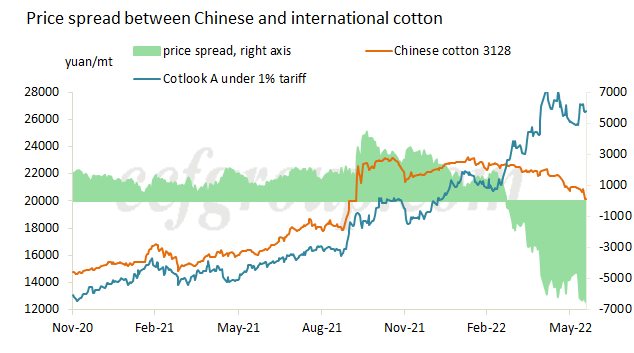What's the reason behind the sharp decline of ZCE cotton?
Since late May, Zhengzhou cotton futures market starts to decline. During May 23 and May 30, the futures market declined sharply. Sep contract once reached the lowest of 20,060yuan/mt, down by 1,975yuan/mt from the highest of 22,035yuan/mt in May. From Jun 15 to Jun 16, the market slumped again. Sep contract once dipped to 19,480yuan/mt in Jun, down by 1,150yuan/mt from the highest of 20,630yuan/mt. The large decline in recent two months is mainly attributed to sluggish downstream demand and large quantity of unsold stocks with the impending arrivals of new cotton. Under this background, the decline in Jun is also impacted by the worries over the US Fed hike in interest rate, coming enforcement of U.S. ban on Xinjiang goods, and the less possibilities of state cotton reserves policy.
After the sharp decline of cotton prices in late May, rumors were in circulation that Xinjiang Agricultural Development Bank would extend the repayment date and Xinjiang Development and Reform Commission required to do study on ginning factories. Xinjiang would hold symposium between the local government and ginning factories on Jun 10-11, awaiting the news about the state cotton reserves policy. Cotton prices fluctuated narrowly overall. But after Jun 11, there was no news about the state cotton reserves policy, so cotton prices lacked certain support.
For state cotton reserves and auction policies, export-oriented spinners hope to sell reserved imported cotton, as the prices are high on the market currently. Cleared Brazilian cotton prices are 2,000-2,400yuan/mt higher than Chinese 3128 cotton, and cleared U.S. cotton prices are higher about 4,000yuan/mt. Imported cotton for forward shipment is about 6,000yuan/mt higher than Chinese 3128 cotton. Therefore, spinners expect to have lower reserved imported cotton to increase the advantages. For Xinjiang ginning factories, who still has large quantity of unsold stocks and heavy losses, they hope the government to purchase Xinjiang cotton into state warehouse, offsetting some losses caused by the U.S. ban on Xinjiang cotton. Therefore, once the Xinjiang cotton is reserved and imported cotton is sold, there may be certain effective effect. But there are several key problem to be considered: 1. Capital issue about the reserves; 2. If the state cotton reserve policy is implemented, how to settle the reserving price? 3. How about the quantity? The demand for imported cotton by export-oriented spinners may be lower than the unsold Xinjiang cotton stocks.
For the ban on Xinjiang cotton, CCFGroup has clear timeline on this issue: Cotton market: Timeline of U.S. bills involved Xinjiang. It has posed impact on the industry in the second half year of 2020 and 2021. The Uyghur Forced Labor Prevention Act (UFLPA) signed by US President Joe Biden back in Dec last year extended the products from cotton and tomato to all goods in Xinjiang. In 2022, foreign apparel brands have stricter requirement on cotton feedstock, so the influence of the ban on Xinjiang cotton continues to deepen. But this is not a sudden issue, and is not the root reason for the decline of cotton prices. When Biden signed the Act on Dec 23, 2021, it has no big impact on the futures market, mainly because the market was amid the positive sentiment, with obvious demand recovery, harvest-rush of ginners and inflation expectation. This year, the recovery after the epidemic sees no advantages, and Chinese demand is also weak. In May 2022, the contradiction of loose supply appears apparently, while international cotton prices hit new high since mid-Mar, leading to high price spread between international and Chinese cotton, above 5,000yuan/mt.

Chinese demand is during a period of shrinking. High cotton price is not the major problem, the shrinking demand is the key. The products in the whole industrial chain are hard to be circulated quickly. China retail sales of garments, footwear, hats and knitwear reduce by 22.8% in April and 16.2% year on year in May. The epidemic poses great impact from Apr, but the influencing time is not only in Apr and May. Cotton prices may still have downward space. From previous operation status, the international cotton prices lag behind the Chinese market for about half a year. In short, ICE cotton futures market is supposed to be hard to slip obviously with tight supply. But high cotton prices have begun to restrain the demand in Southeast Asia. In the medium to long run, after the supply turns to be loose, international cotton prices may turn weak, and support to Chinese cotton market will weaken. For Chinese cotton market, with no obvious industrial support policy, price will be weaker.
- Top keywords
- Cotton Price
- Cotton Futures Price
- Cotton Futures
- CZCE
- PTA Futures Price
- Chemical Fiber
- Polyester Prices
- Wool price
- PTA Futures
- Shengze Silk
- China
- Yarn Price
- price
- China Textile City
- Fibre Price
- Benzene Price
- Cotton
- Index
- Cotton Index
- PTA
- fabric price
- NYMEX
- Top 10
- textile industry
- Spot Cotton
- Cotton Yarn
- Polyester Price
- Futures
- PTA Price
- cotton yarn price

